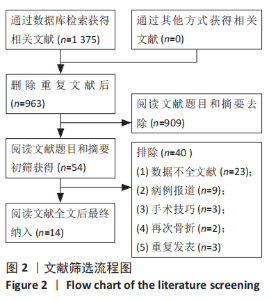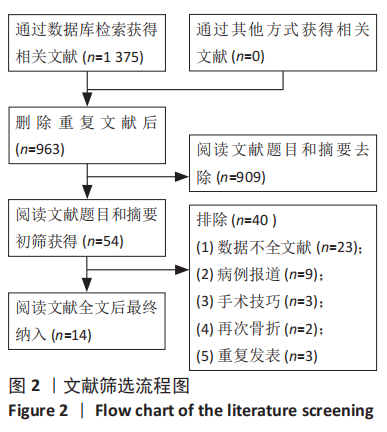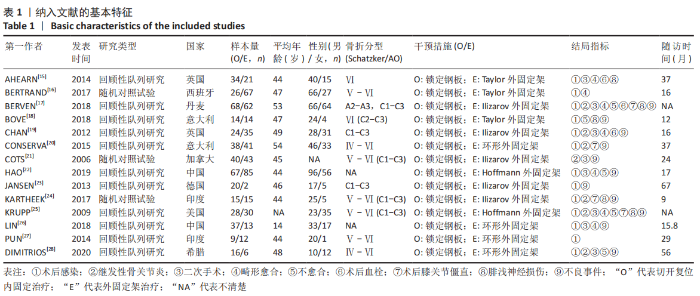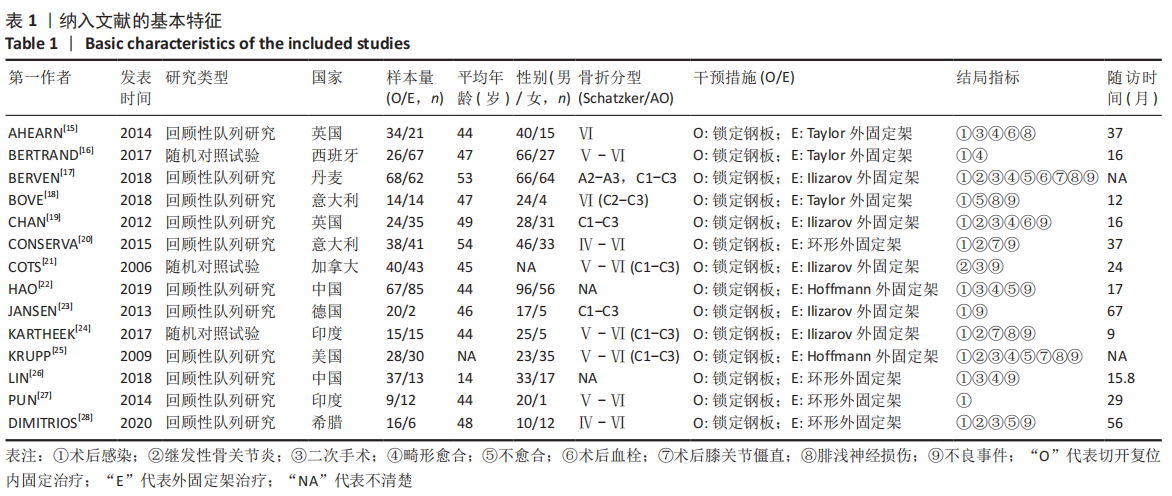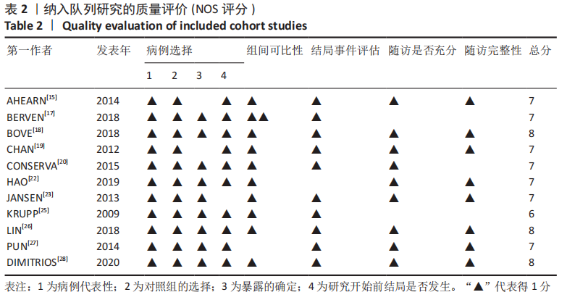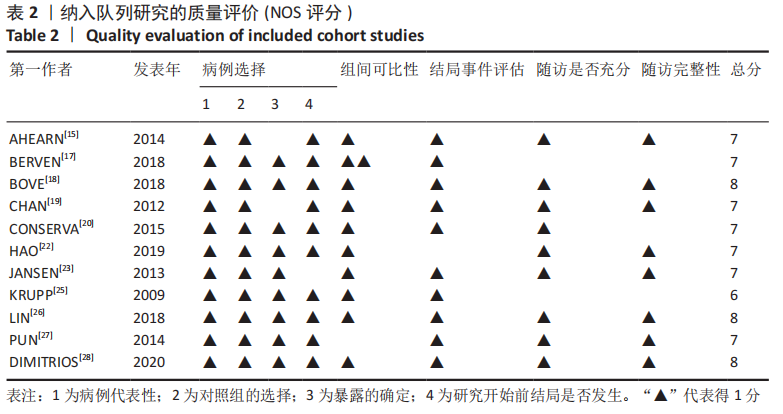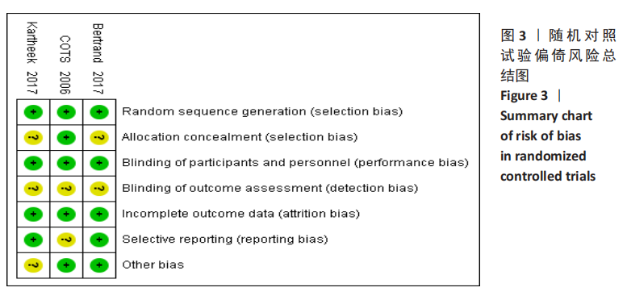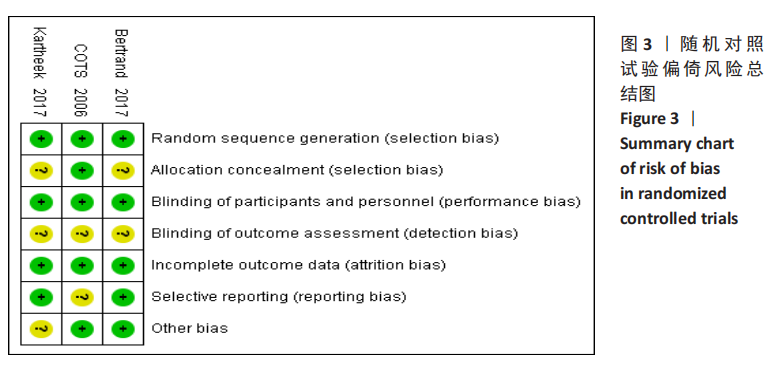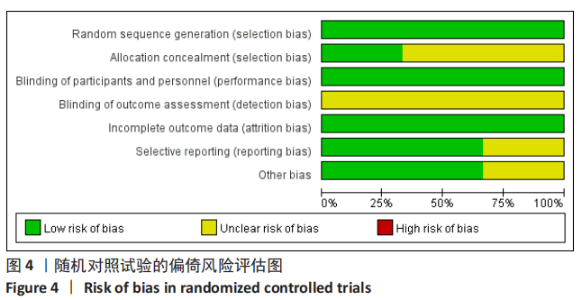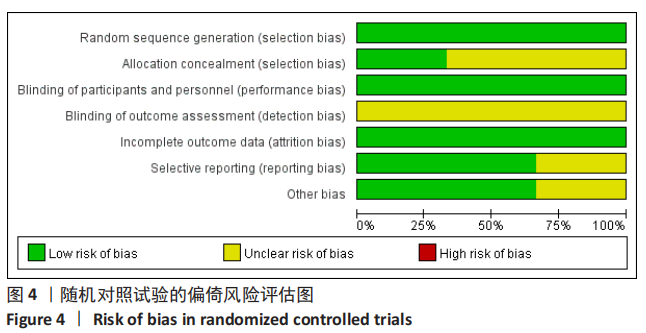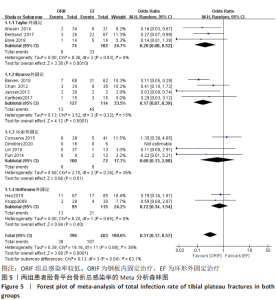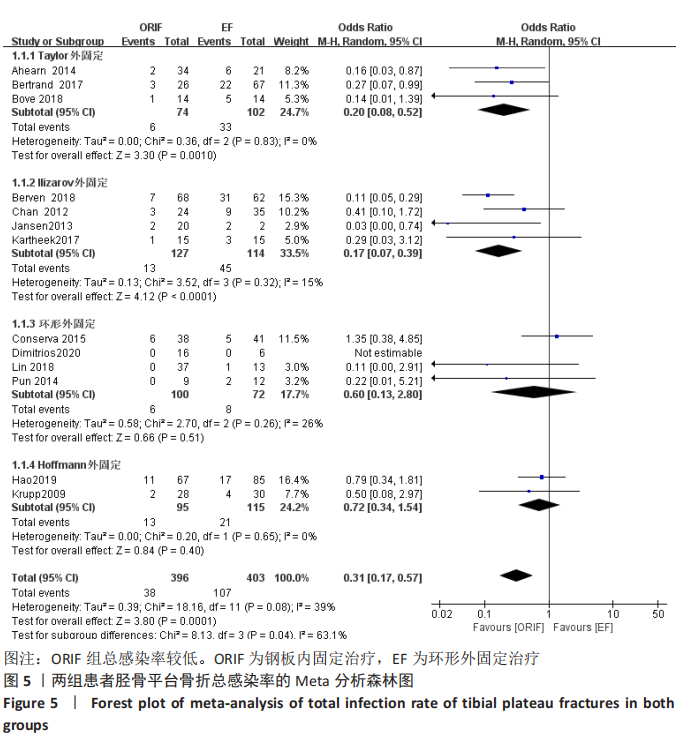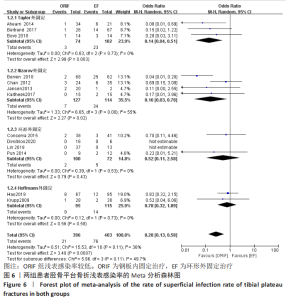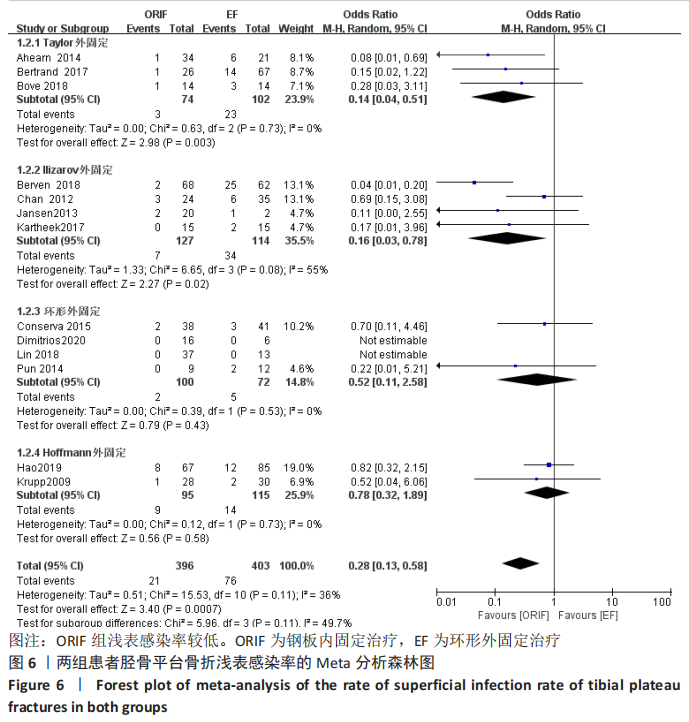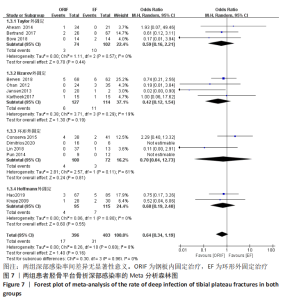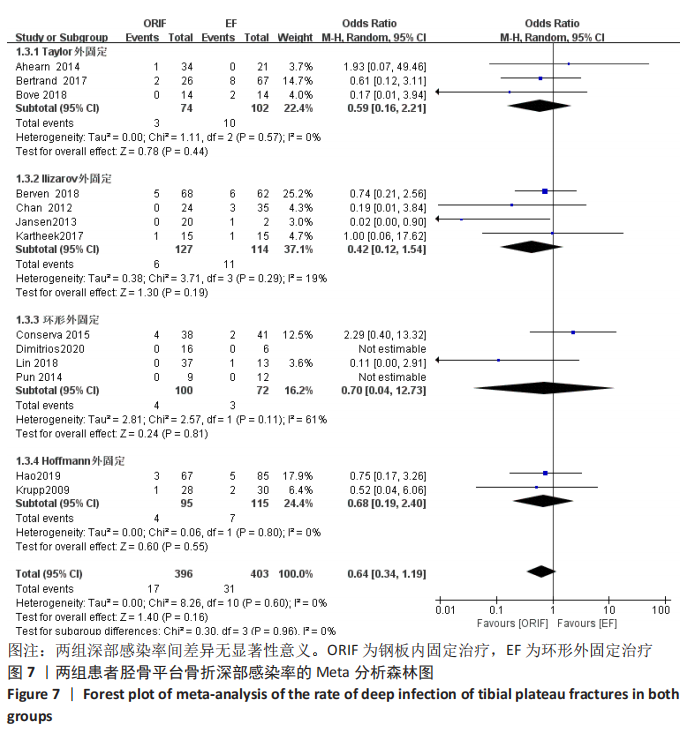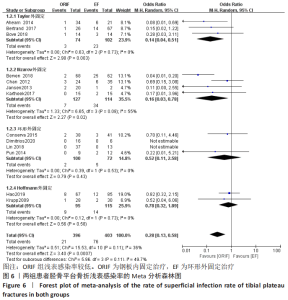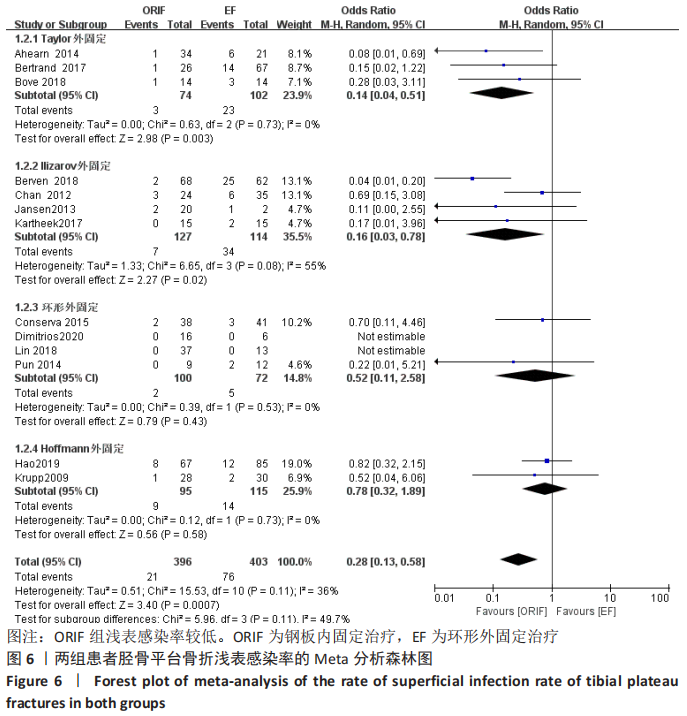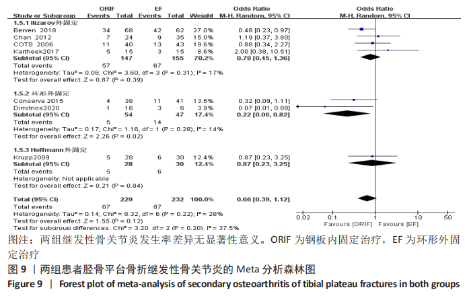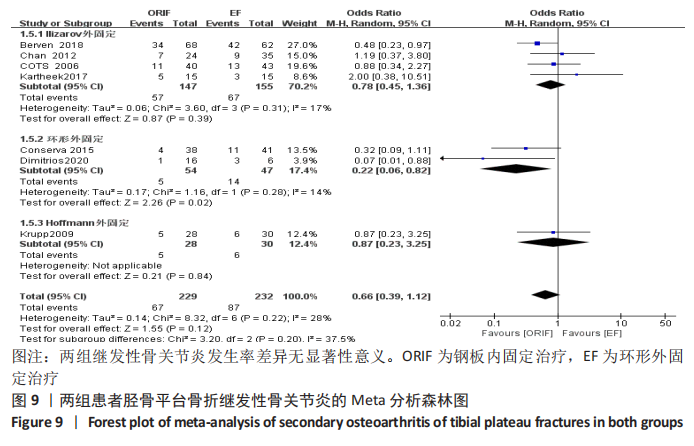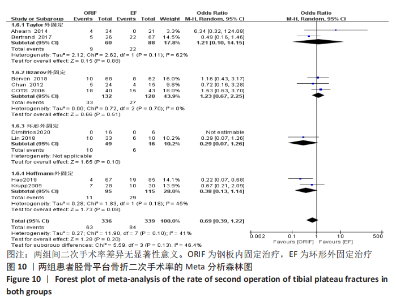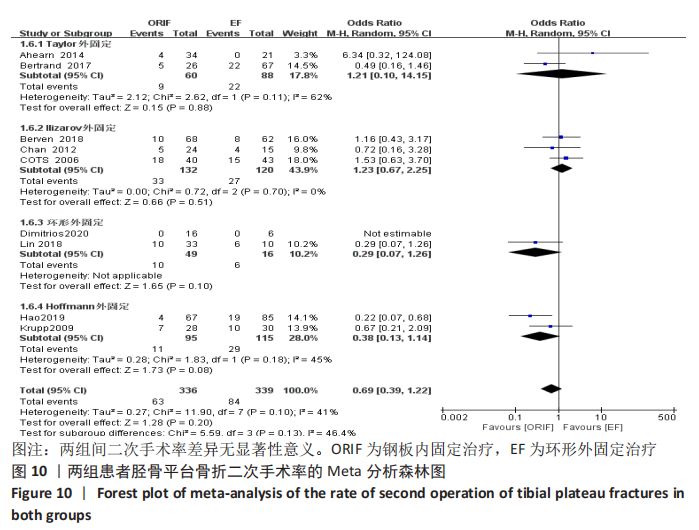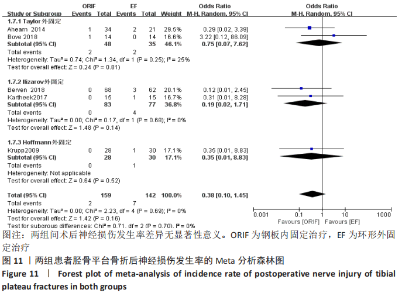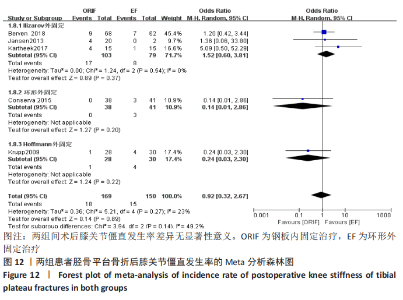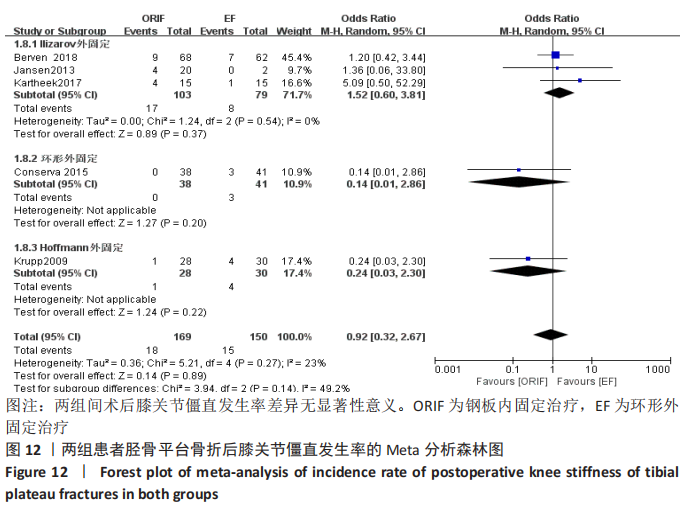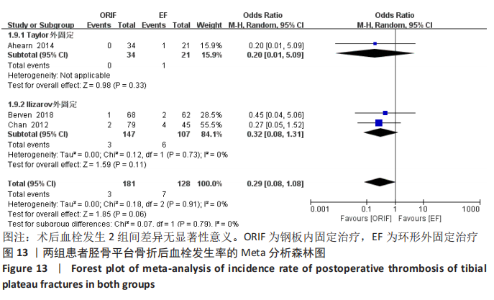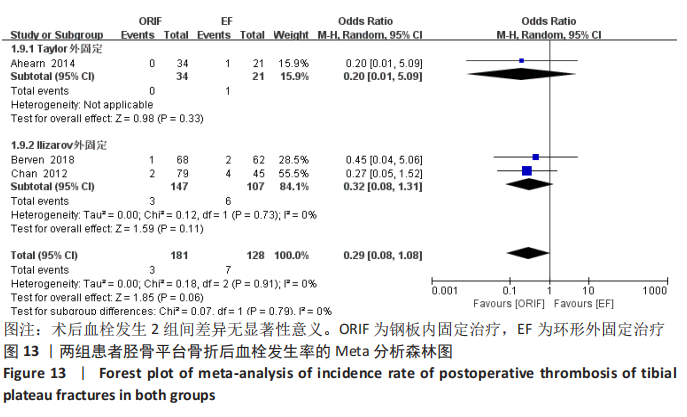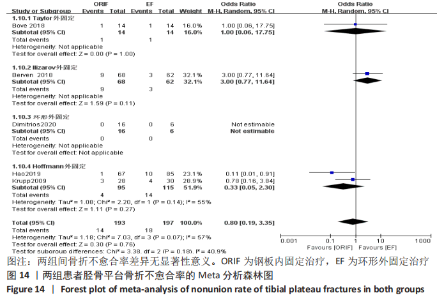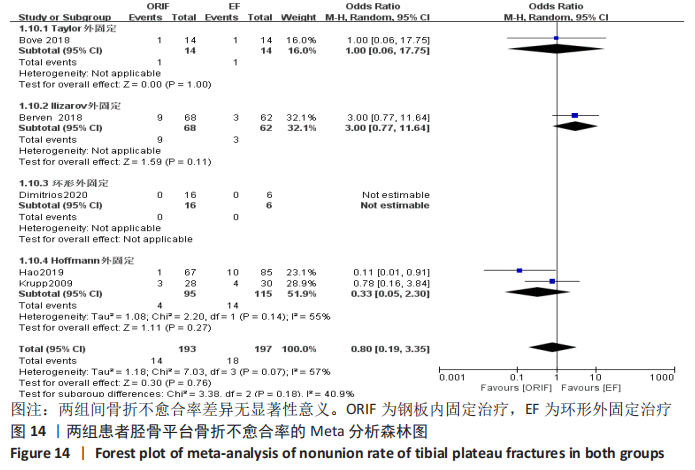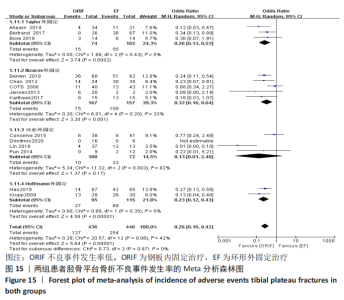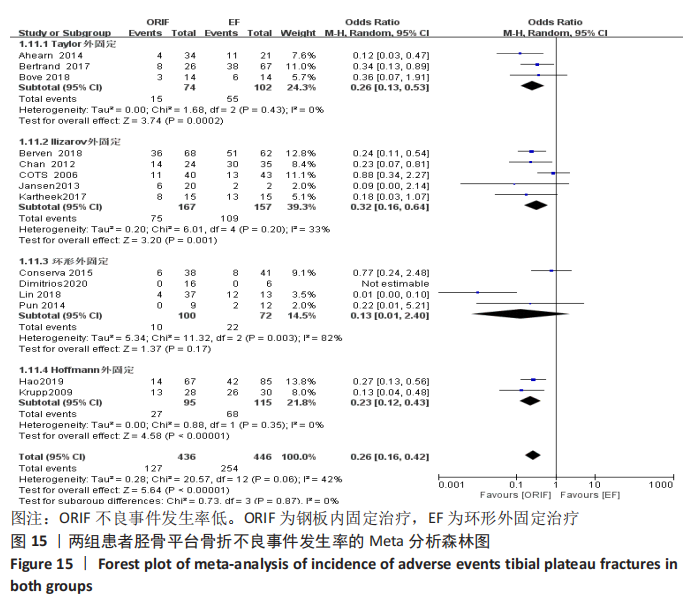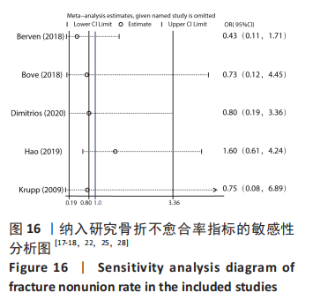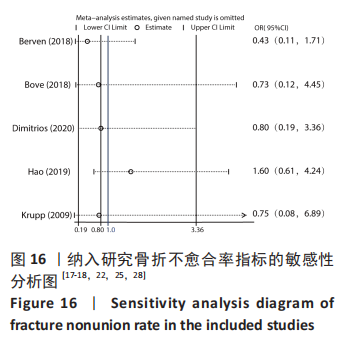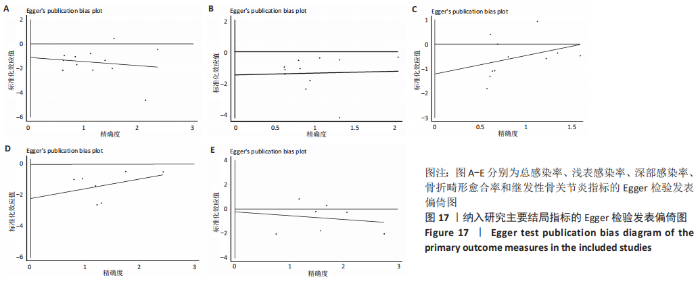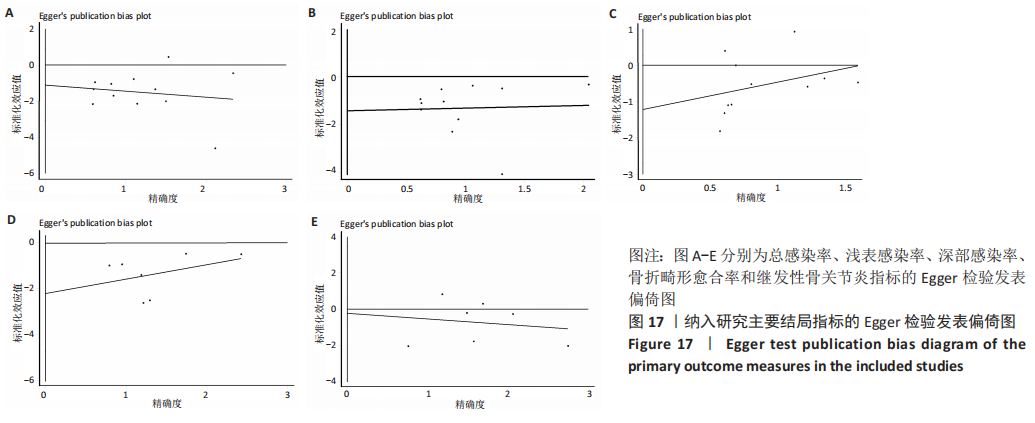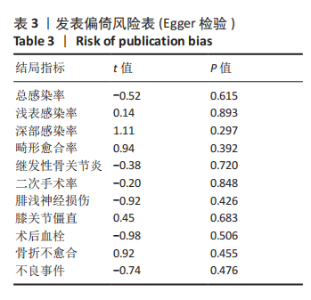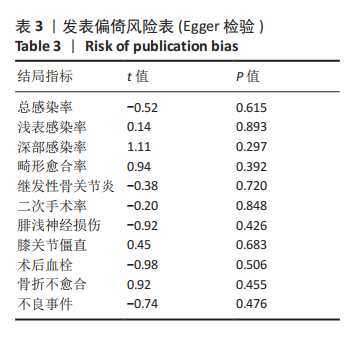Chinese Journal of Tissue Engineering Research ›› 2021, Vol. 25 ›› Issue (36): 5888-5896.doi: 10.12307/2021.359
Previous Articles Next Articles
Meta-analysis of postoperative complications of circular external fixation and internal fixation with steel plate for the treatment of tibial plateau fractures
Song Lei1, Zhang Hui1, Zhao Yangfei1, Sun Haiyu2
- 1Shanxi Medical University, Taiyuan 030000, Shanxi Province, China; 2Department of Orthopedics, Second Hospital of Shanxi Medical University, Taiyuan 030000, Shanxi Province, China
-
Received:2021-03-02Revised:2021-03-04Accepted:2021-03-31Online:2021-12-28Published:2021-09-18 -
Contact:Sun Haiyu, MD, Chief physician, Department of Orthopedics, Second Hospital of Shanxi Medical University, Taiyuan 030000, Shanxi Province, China -
About author:Song Lei, Master candidate, Physician, Shanxi Medical University, Taiyuan 030000, Shanxi Province, China
CLC Number:
Cite this article
Song Lei, Zhang Hui, Zhao Yangfei, Sun Haiyu. Meta-analysis of postoperative complications of circular external fixation and internal fixation with steel plate for the treatment of tibial plateau fractures[J]. Chinese Journal of Tissue Engineering Research, 2021, 25(36): 5888-5896.
share this article
Add to citation manager EndNote|Reference Manager|ProCite|BibTeX|RefWorks
| [1] RAMPONI DR, MCSWIGAN T. Tibial plateau fractures. Adv Emerg Nurs J. 2018;40(3):155-161. [2] HE QF, SUN H, SHU LY, et al. Tibial plateau fractures in elderly people: an institutional retrospective study. J Orthop Surg Res. 2018;13(1):276. [3] BIGGI F, DI FABIO S, D’ANTIMO C, et al. Tibial plateau fractures: internal fixation with locking plates and the MIPO technique. Injury. 2010; 41(11):1178-1182. [4] KUGELMAN DN, QATU AM, STRAUSS EJ, et al. Knee stiffness after tibial plateau fractures: predictors and outcomes (OTA-41). J Orthop Trauma. 2018; 32(11):e421-e427. [5] ADAMS JDJ, LOEFFLER MF. Soft tissue injury considerations in the treatment of tibial plateau fractures. Orthop Clin North Am. 2020;51(4): 471-479. [6] MTHETHWA J, CHIKATE A. A review of the management of tibial plateau fractures. Musculoskelet Surg. 2018;102(2):119-127. [7] 张英泽.胫骨平台骨折诊疗创新与发展再探索[J].中华创伤骨科杂志,2020,22(8):662-664. [8] KRAUSE M, MüLLER G, FROSCH KH. Surgical approaches to tibial plateau fractures. Unfallchirurg. 2018;121(7):569-582. [9] MENGHI A, MAZZITELLI G, MARZETTI E, et al. Complex tibial plateau fractures: a retrospective study and proposal of treatment algorithm. Injury. 2017;48 Suppl 3:S1-S6. [10] ELSOE R, JOHANSEN MB, LARSEN P. Tibial plateau fractures are associated with a long-lasting increased risk of total knee arthroplasty a matched cohort study of 7,950 tibial plateau fractures. Osteoarthritis Cartilage. 2019;27(5):805-809. [11] BALOCH SR, RAFI MS, JUNAID J, et al. Ilizarov fixation method of tibia plateau fractures: a prospective observational study. Cureus. 2020; 12(10):e11277. [12] ZHAO XW, MA JX, MA XL, et al. A meta-analysis of external fixation versus open reduction and internal fixation for complex tibial plateau fractures. Int J Surg. 2017;39:65-73. [13] BOUTEFNOUCHET T, LAKDAWALA AS, MAKRIDES P. Outcomes following the treatment of bicondylar tibial plateau fractures with fine wire circular frame external fixation compared to open reduction and internal fixation: a systematic review. J Orthop. 2016;13(3):193-199. [14] MARION-MARTINS AD, PINHO DLM. Interprofessional simulation effects for healthcare students: a systematic review and meta-analysis. Nurse Educ Today. 2020;94:104568. [15] AHEARN N, OPPY A, HALLIDAY R, et al. The outcome following fixation of bicondylar tibial plateau fractures. Bone Joint J. 2014;96-b(7):956-962. [16] BERTRAND ML, PASCUAL-LóPEZ FJ, GUERADO E. Severe tibial plateau fractures (Schatzker V-VI): open reduction and internal fixation versus hybrid external fixation. Injury. 2017;48 Suppl 6: S81-S85. [17] BERVEN H, BRIX M, IZADPANAH K, et al. Comparing case-control study for treatment of proximal tibia fractures with a complete metaphyseal component in two centers with different distinct strategies: fixation with Ilizarov frame or locking plates. J Orthop Surg Res. 2018; 13(1):121. [18] BOVE F, SALA F, CAPITANI P, et al. Treatment of fractures of the tibial plateau (Schatzker VI) with external fixators versus plate osteosynthesis. Injury. 2018;49 Suppl 3:S12-S18. [19] CHAN C, KEATING J. Comparison of outcomes of operatively treated bicondylar tibial plateau fractures by external fixation and internal fixation. Malays Orthop J. 2012;6(1):7-12. [20] CONSERVA V, VICENTI G, ALLEGRETTI G, et al. Retrospective review of tibial plateau fractures treated by two methods without staging. Injury. 2015;46(10):1951-1956. [21] SOCIETY COT. Open reduction and internal fixation compared with circular fixator application for bicondylar tibial plateau fractures. Results of a multicenter, prospective, randomized clinical trial. J Bone Joint Surg Am. 2006;88(12):2613-2623. [22] HAO ZC, XIA Y, XIA DM, et al. Treatment of open tibial diaphyseal fractures by external fixation combined with limited internal fixation versus simple external fixation: a retrospective cohort study. BMC Musculoskelet Disord. 2019; 20(1):311. [23] JANSEN H, FREY SP, DOHT S, et al. Medium-term results after complex intra-articular fractures of the tibial plateau. J Orthop Sci. 2013;18(4):569-577. [24] KODANDAPANI K. Ilizarov and locking plate fixation for closed bicondylar tibial plateau fracturesa prospective study. J Evol Med Dent Sci. 2017;6(64):4670-4675. [25] KRUPP RJ, MALKANI AL, ROBERTS CS, et al. Treatment of bicondylar tibia plateau fractures using locked plating versus external fixation. Orthopedics. 2009. doi: 10.3928/01477447-20090624-11. [26] LIN L, LIU Y, LIN C, et al. Comparison of three fixation methods in treatment of tibial fracture in adolescents. ANZ J Surg. 2018;88(6):E480-E485. [27] PUN TB, KRISHNAMOORTHY VP, POONNOOSE PM, et al. Outcome of Schatzker type V and VI tibial plateau fractures. Indian J Orthop. 2014; 48(1):35-41. [28] EVANGELOPOULOS D, CHALIKIAS S, MICHALOS M, et al. Medium-term results after surgical treatment of high-energy tibial plateau fractures. J Knee Surg. 2020;33(4): 394-398. [29] TAHIR M, KUMAR S, SHAIKH SA, et al. Comparison of postoperative outcomes between open reduction and internal fixation and ilizarov for schatzker type V and type VI fractures. Cureus. 2019;11(6):e4902. [30] YOUNG MJ, BARRACK RL. Complications of internal fixation of tibial plateau fractures. Orthop Rev. 1994;23(2):149-154. [31] JENSEN DB, RUDE C, DUUS B, et al. Tibial plateau fractures. A comparison of conservative and surgical treatment. J Bone Joint Surg Br. 1990; 72(1):49-52. [32] HALL JA, BEUERLEIN MJ, MCKEE MD. Open reduction and internal fixation compared with circular fixator application for bicondylar tibial plateau fractures. Surgical technique. J Bone Joint Surg Am. 2009;91 Suppl 2 Pt 1:74-88. [33] KEIGHTLEY AJ, NAWAZ SZ, JACOB JT, et al. Ilizarov management of Schatzker IV to VI fractures of the tibial plateau: 105 fractures at a mean follow-up of 7.8 years. Bone Joint J. 2015;97-b(12):1693-1697. [34] CHIN TY, BARDANA D, BAILEY M, et al. Functional outcome of tibial plateau fractures treated with the fine-wire fixator. Injury. 2005;36(12):1467-1475. [35] METCALFE D, HICKSON CJ, MCKEE L, et al. External versus internal fixation for bicondylar tibial plateau fractures: systematic review and meta-analysis. J Orthop Traumatol. 2015;16(4):275-285. [36] COLE PA, ZLOWODZKI M, KREGOR PJ. Treatment of proximal tibia fractures using the less invasive stabilization system: surgical experience and early clinical results in 77 fractures. J Orthop Trauma. 2004;18(8):528-535. [37] MORANDI MM, LANDI S, KILAGHBIAN V, et al. Schatzker type VI tibial plateau fractures and the Ilizarov circular external fixator. Bull Hosp Jt Dis. 1997;56(1):46-48. [38] CATAGNI MA, OTTAVIANI G, MAGGIONI M. Treatment strategies for complex fractures of the tibial plateau with external circular fixation and limited internal fixation. J Trauma. 2007;63(5):1043-1053. [39] LIU F, TAO R, CAO Y, et al. The role of LISS (less invasive stabilisation system) in the treatment of peri-knee fractures. Injury. 2009;40(11):1187-1194. [40] MAHADEVA D, COSTA ML, GAFFEY A. Open reduction and internal fixation versus hybrid fixation for bicondylar/severe tibial plateau fractures: a systematic review of the literature. Arch Orthop Trauma Surg. 2008;128(10): 1169-1175. [41] PHISITKUL P, MCKINLEY TO, NEPOLA JV, et al. Complications of locking plate fixation in complex proximal tibia injuries. J Orthop Trauma. 2007;21(2):83-91. [42] GAUDINEZ RF, MALLIK AR, SZPORN M. Hybrid external fixation of comminuted tibial plateau fractures. Clin Orthop Relat Res. 1996;(328): 203-210. |
| [1] | Wei Wei, Li Jian, Huang Linhai, Lan Mindong, Lu Xianwei, Huang Shaodong. Factors affecting fall fear in the first movement of elderly patients after total knee or hip arthroplasty [J]. Chinese Journal of Tissue Engineering Research, 2021, 25(9): 1351-1355. |
| [2] | Wang Jinjun, Deng Zengfa, Liu Kang, He Zhiyong, Yu Xinping, Liang Jianji, Li Chen, Guo Zhouyang. Hemostatic effect and safety of intravenous drip of tranexamic acid combined with topical application of cocktail containing tranexamic acid in total knee arthroplasty [J]. Chinese Journal of Tissue Engineering Research, 2021, 25(9): 1356-1361. |
| [3] | Xiao Guoqing, Liu Xuanze, Yan Yuhao, Zhong Xihong. Influencing factors of knee flexion limitation after total knee arthroplasty with posterior stabilized prostheses [J]. Chinese Journal of Tissue Engineering Research, 2021, 25(9): 1362-1367. |
| [4] | Huang Zexiao, Yang Mei, Lin Shiwei, He Heyu. Correlation between the level of serum n-3 polyunsaturated fatty acids and quadriceps weakness in the early stage after total knee arthroplasty [J]. Chinese Journal of Tissue Engineering Research, 2021, 25(9): 1375-1380. |
| [5] | Zhang Chong, Liu Zhiang, Yao Shuaihui, Gao Junsheng, Jiang Yan, Zhang Lu. Safety and effectiveness of topical application of tranexamic acid to reduce drainage of elderly femoral neck fractures after total hip arthroplasty [J]. Chinese Journal of Tissue Engineering Research, 2021, 25(9): 1381-1386. |
| [6] | Wang Haiying, Lü Bing, Li Hui, Wang Shunyi. Posterior lumbar interbody fusion for degenerative lumbar spondylolisthesis: prediction of functional prognosis of patients based on spinopelvic parameters [J]. Chinese Journal of Tissue Engineering Research, 2021, 25(9): 1393-1397. |
| [7] | Lü Zhen, Bai Jinzhu. A prospective study on the application of staged lumbar motion chain rehabilitation based on McKenzie’s technique after lumbar percutaneous transforaminal endoscopic discectomy [J]. Chinese Journal of Tissue Engineering Research, 2021, 25(9): 1398-1403. |
| [8] | Chen Xinmin, Li Wenbiao, Xiong Kaikai, Xiong Xiaoyan, Zheng Liqin, Li Musheng, Zheng Yongze, Lin Ziling. Type A3.3 femoral intertrochanteric fracture with augmented proximal femoral nail anti-rotation in the elderly: finite element analysis of the optimal amount of bone cement [J]. Chinese Journal of Tissue Engineering Research, 2021, 25(9): 1404-1409. |
| [9] | Du Xiupeng, Yang Zhaohui. Effect of degree of initial deformity of impacted femoral neck fractures under 65 years of age on femoral neck shortening [J]. Chinese Journal of Tissue Engineering Research, 2021, 25(9): 1410-1416. |
| [10] | Zhang Shangpu, Ju Xiaodong, Song Hengyi, Dong Zhi, Wang Chen, Sun Guodong. Arthroscopic suture bridge technique with suture anchor in the treatment of acromioclavicular dislocation [J]. Chinese Journal of Tissue Engineering Research, 2021, 25(9): 1417-1422. |
| [11] | Liang Yan, Zhao Yongfei, Xu Shuai, Zhu Zhenqi, Wang Kaifeng, Liu Haiying, Mao Keya. Imaging evaluation of short-segment fixation and fusion for degenerative lumbar scoliosis assisted by highly selective nerve root block [J]. Chinese Journal of Tissue Engineering Research, 2021, 25(9): 1423-1427. |
| [12] | Zhang Chao, Lü Xin. Heterotopic ossification after acetabular fracture fixation: risk factors, prevention and treatment progress [J]. Chinese Journal of Tissue Engineering Research, 2021, 25(9): 1434-1439. |
| [13] | Zhou Jihui, Li Xinzhi, Zhou You, Huang Wei, Chen Wenyao. Multiple problems in the selection of implants for patellar fracture [J]. Chinese Journal of Tissue Engineering Research, 2021, 25(9): 1440-1445. |
| [14] | Wang Debin, Bi Zhenggang. Related problems in anatomy mechanics, injury characteristics, fixed repair and three-dimensional technology application for olecranon fracture-dislocations [J]. Chinese Journal of Tissue Engineering Research, 2021, 25(9): 1446-1451. |
| [15] | Chen Junming, Yue Chen, He Peilin, Zhang Juntao, Sun Moyuan, Liu Youwen. Hip arthroplasty versus proximal femoral nail antirotation for intertrochanteric fractures in older adults: a meta-analysis [J]. Chinese Journal of Tissue Engineering Research, 2021, 25(9): 1452-1457. |
| Viewed | ||||||
|
Full text |
|
|||||
|
Abstract |
|
|||||
